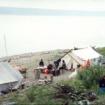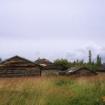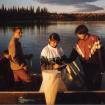White Moss (Reindeer lichen)
This lichen grows in large mats in spruce forests, where it is often eaten by caribou. According to Alfred Semple, Lazarus Sittichinli said it takes a long time to grow. He also told Alfred that if you eat animals that eat willow, like moose, you will get hungry more quickly than eating animals that eat lichen, like caribou. William Teya said, as children, they were taught to respect the lichen. Children were not supposed to play on it and if you took some, you were to pay for it.
English



